These rose pavlova cakes are delicate, dreamy, and made to impress — whether it’s a bridal shower, romantic dinner, or just a sweet gift to yourself.
Light meringue shells, scented with rose and filled with soft whipped cream, make these mini desserts feel both elegant and effortless.
They’re naturally gluten-free, make-ahead friendly, and surprisingly simple if you follow a few key steps.
In this recipe, you’ll learn how to make them from scratch, flavor them for any occasion, and decorate them like a pro — no pastry chef credentials needed.
Let’s dive into the ingredients and make your kitchen smell like a bouquet.
Table of Contents
🥒 Ingredients for Rose Pavlova Cakes
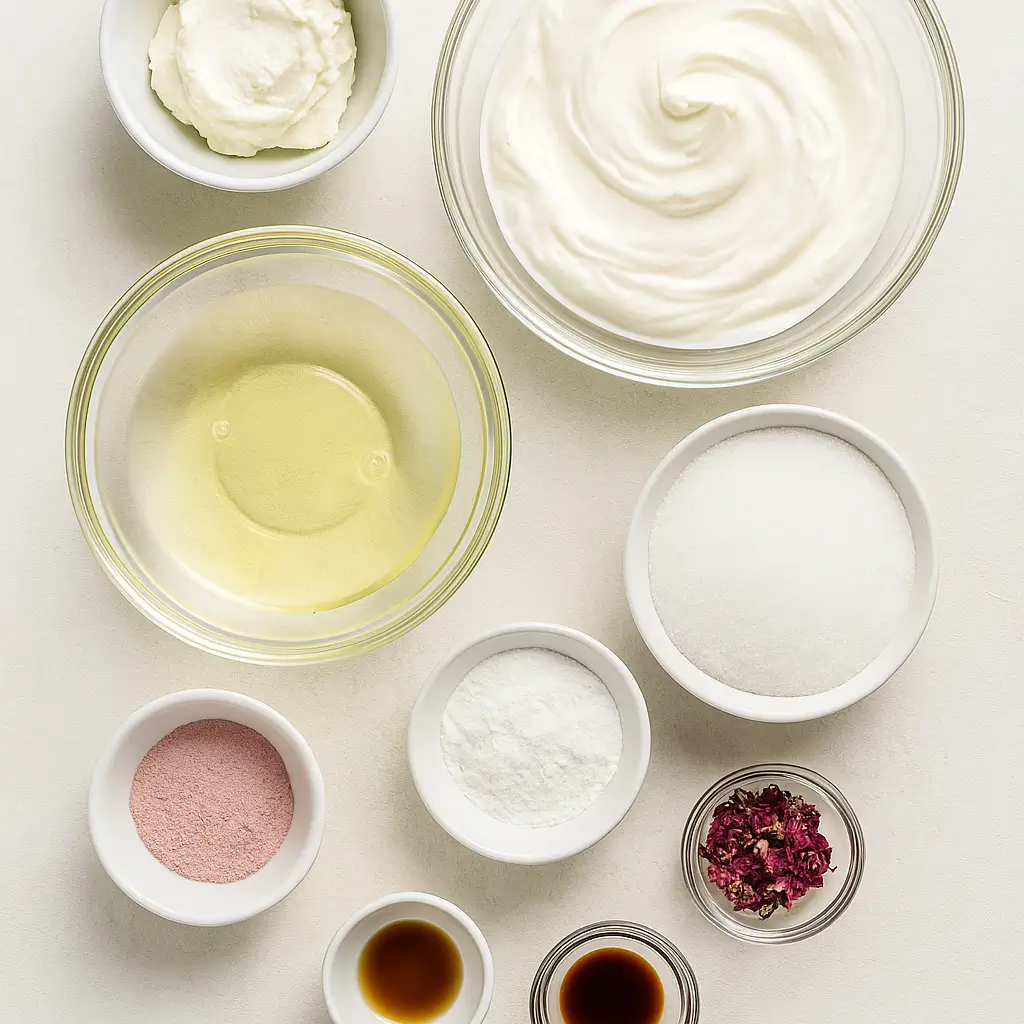
To make these delicate rose pavlova cakes, you’ll need just a handful of pantry and fridge staples — plus a floral twist. Here’s everything to gather before you begin:
Pavlova Base:
- 3 egg whites, at room temperature
- 1 teaspoon dried rose petal powder (optional, for color and aroma)
- ½ cup white sugar (plus more to taste)
- 1 teaspoon vanilla extract
- ½ teaspoon rose extract (adjust to preference)
- 1 teaspoon cornstarch (or ¼ tsp cream of tartar as a substitute)
Whipped Cream Filling:
- 1½ tablespoons cream cheese
- 1 cup heavy whipping cream
- 2 tablespoons white sugar
Decoration:
- 1 tablespoon dried rose petals (optional, for garnish)
- Optional: Food coloring (pink or pastel tones work beautifully)
🌹 Tip: How to Make Rose Petal Powder
Grind 1–2 tablespoons of dried rose petals in a spice grinder until fine. Store in an airtight jar for use in baked goods, tea blends, or syrups.
🗘️ Occasion-Based Add-Ons:
- Add strawberry jam for a fruity twist
- Use edible gold dust for weddings
- Sprinkle crushed pistachios for a Middle Eastern flair
FAQ Highlight:
Q: Can I skip the rose extract?
A: You can, but it’s what gives this dessert its signature floral charm. If skipping, boost the vanilla slightly and consider adding a touch of lemon zest for brightness.
🍰 How to Make Rose Pavlova Cakes (Step-by-Step Instructions)
Making pavlova might sound fancy, but it’s all about timing and gentle handling. Here’s how to get that crisp shell and marshmallow-soft center every time.
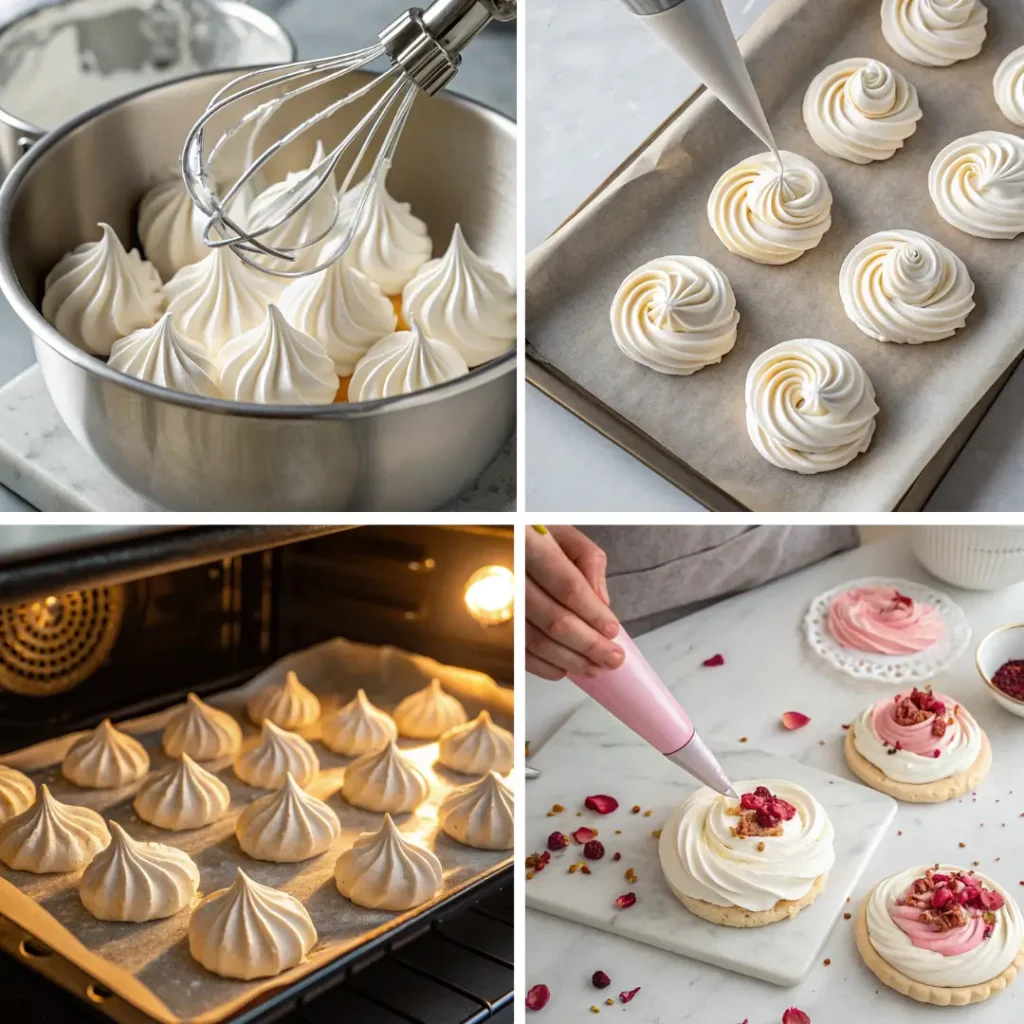
Step 1: Preheat and Prep
- Preheat your oven to 225°F (110°C).
- Line a baking sheet with parchment paper — don’t skip this, or your pavlovas might stick.
Step 2: Whip the Meringue
- In a stand mixer bowl, combine egg whites and rose petal powder.
- Beat on medium until soft peaks form.
- Slowly add ½ cup sugar, increasing to high speed until stiff, glossy peaks form.
- Add vanilla and rose extract.
- Gently fold in the cornstarch with a spatula — don’t overmix.
Visual cue: Stiff peaks should hold their shape and have a shiny sheen.
Step 3: Pipe and Bake
- Spoon meringue into a piping bag fitted with a round tip.
- Pipe 18 small rounds onto the baking sheet.
- Bake for 1 hour 15 minutes, then turn off the oven.
- Leave them inside for another 20–25 minutes to fully dry out.
Human tip: Resist opening the oven door — sudden temp drops can cause cracks.
Step 4: Cool Completely
- Let pavlovas cool on the tray for about 30 minutes before decorating.
Step 5: Make the Whipped Cream
- Beat cream cheese for 30 seconds.
- Add heavy cream and 2 tbsp sugar, and whip until soft, fluffy peaks form.
- Transfer to a clean piping bag.
Step 6: Assemble and Decorate
- Pipe whipped cream onto each pavlova.
- Sprinkle with dried rose petals or extras like edible gold or berries.
(Learn how rose extract compares to rose water and how to DIY it.)
FAQ Highlight:
Q: Can I make pavlovas the day before?
A: Yes! Store unfilled meringue shells in an airtight container at room temp for 3–5 days. Fill just before serving to keep them crisp.
🧁 Tips for Perfect Mini Pavlovas
Pavlovas are all about finesse — but that doesn’t mean they’re fragile to the point of failure. These tips will help you get it right the first time (and every time after).
💡 Don’t Rush the Meringue
Take your time whipping the egg whites. Soft peaks to stiff peaks is a journey — rushing it can lead to a collapsed pavlova or grainy texture.
- Use room temperature egg whites
- Add sugar slowly to avoid deflating the foam
- Stop whipping as soon as stiff peaks form — they should be glossy and stand tall
🌡️ Oven Discipline = No Cracks
Opening the oven mid-bake? Recipe sabotage.
- Always bake low and slow (225°F is your friend)
- Turn off the oven and leave the pavlovas inside after baking — this gradual cooling prevents cracking
- Don’t bake on a humid day if you can help it
🛠️ Common Mistakes + Fixes
Pavlova Cracked or Collapsed?
Cause: Too hot, too fast — or overwhipped
Fix: Lower temp next time, and whip just until peaks hold
Sticky Bottoms?
Cause: Underbaked
Fix: Add 10–15 minutes next time and let them rest fully in the oven
Flat Meringue?
Cause: Overmixed after adding sugar
Fix: Beat sugar in slowly, and stop once the mixture is shiny and firm
🧊 Storage & Make-Ahead Tips
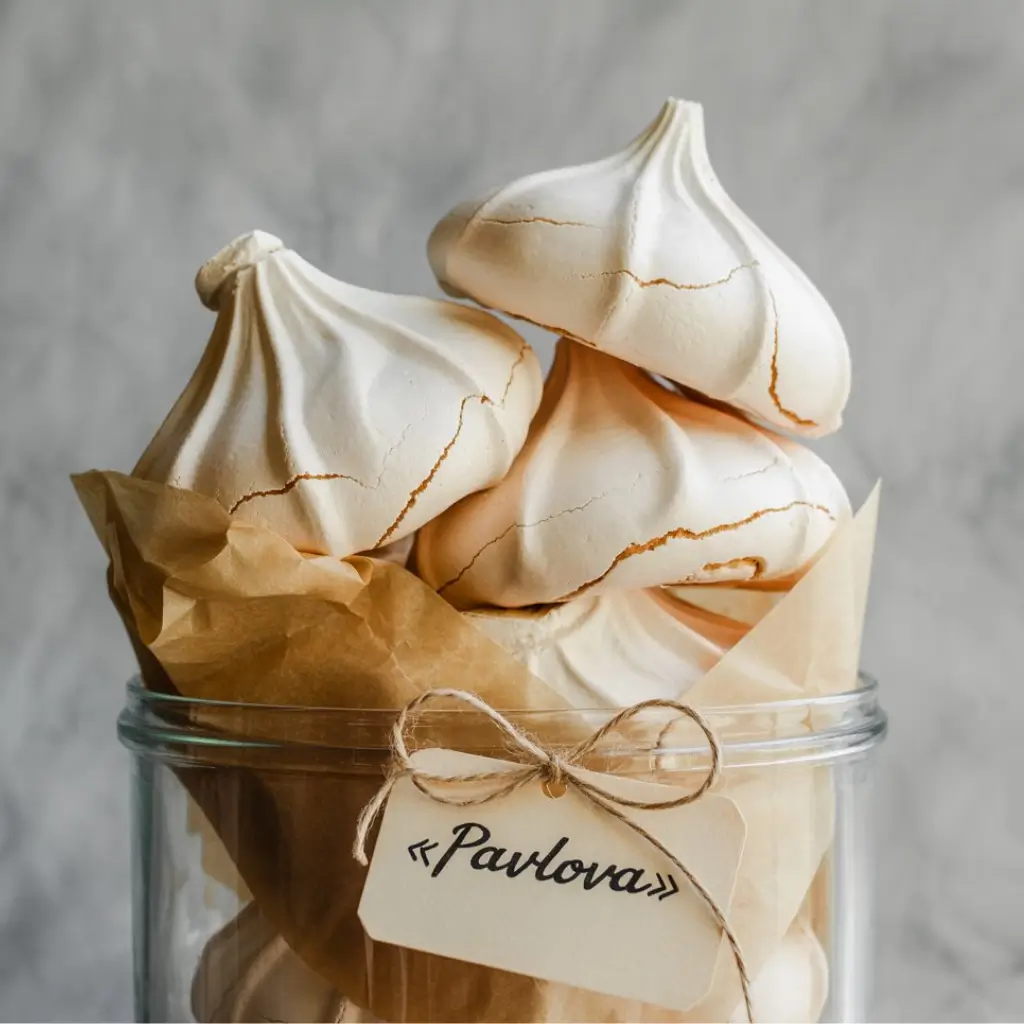
- Unfilled pavlovas: Store in an airtight container at room temp for up to 5 days
- Filled pavlovas: Best enjoyed within a few hours — the cream softens the shell
- Whipped cream: Can be made a day ahead and stored chilled
FAQ Highlight:
Q: Why are my pavlovas chewy instead of crisp?
A: High humidity or underbaking are common culprits. Try baking a bit longer, and avoid storing them in a humid kitchen.
🎨 Creative Variations for Any Occasion
Rose pavlovas are already elegant — but with a few small tweaks, they can become anything from playful to poetic. Here’s how to dress them up for different moments and moods.
💘 Valentine’s Day
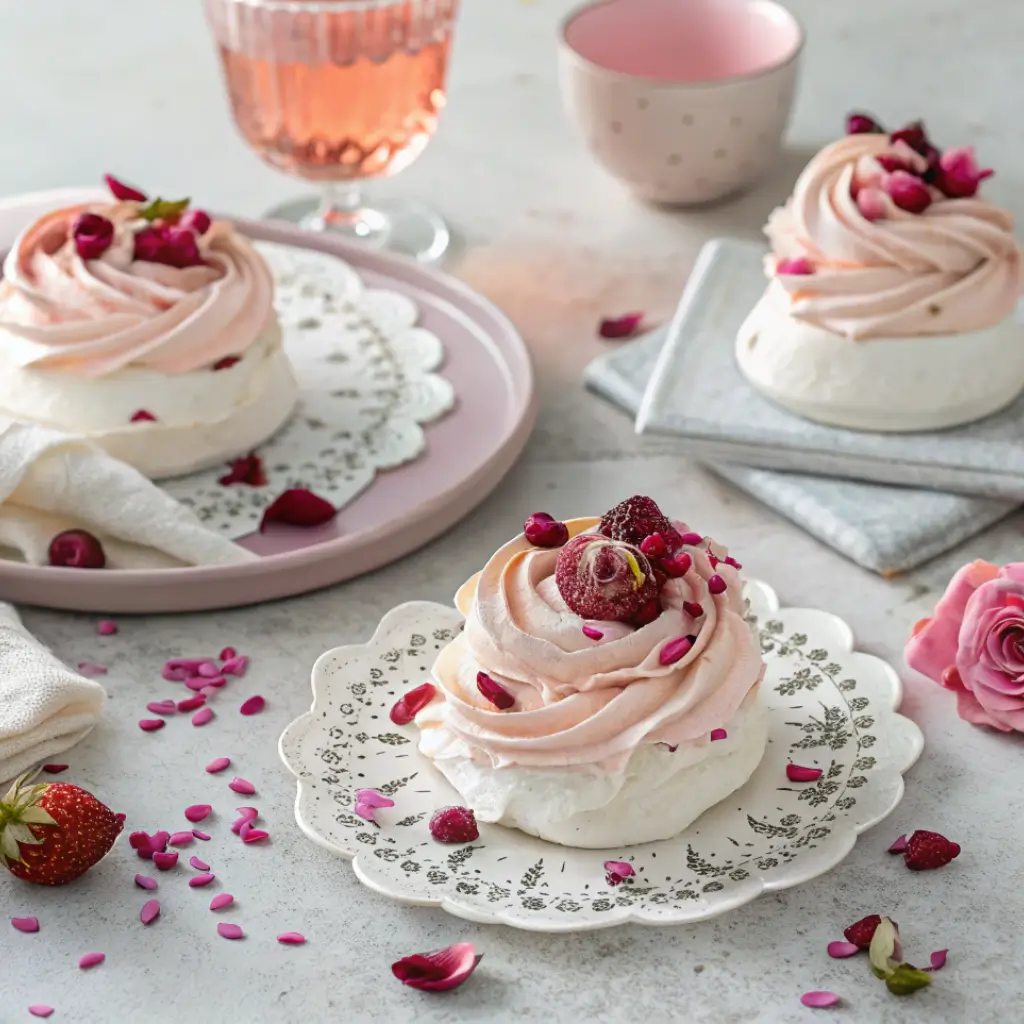
- Tint the whipped cream a soft blush with natural beet or pink gel coloring
- Pipe pavlovas into heart shapes
- Top with a drizzle of strawberry jam and crushed freeze-dried berries
💍 Bridal Showers or Weddings
- Use a flower piping tip to create rosette shapes
- Dust with edible gold, silver pearls, or dried violets
- Serve on vintage trays or cupcake stands for an elegant touch
🧒 Kids’ Birthday Parties
- Add a few drops of food coloring to make pastel pavlovas
- Top with rainbow sprinkles or mini chocolate chips
- Serve in cupcake wrappers for easy handling
🌿 Middle Eastern Flair
- Add a pinch of cardamom or saffron to the meringue
- Swap cream cheese for mascarpone in the whipped filling
- Garnish with crushed pistachios and rose petals
🔹 DIY Bar Idea
Let guests build their own! Set out unfilled pavlovas, whipped cream, fruit compotes, and toppings. Perfect for events or brunches.
✨ Occasion-Based Pairings
- Drink with: Rose tea, sparkling rosé, lavender lemonade
- Serve with: Fresh berries, Turkish delight, or almond cookies
FAQ Highlight:
Q: Can I change the flavor entirely?
A: Yes! Try replacing rose extract with orange blossom, lavender, or lemon zest for totally different vibes. Pavlovas are incredibly flexible.
The Science of Meringue (Why It Works)
Pavlova may feel like magic, but it’s really just well-behaved chemistry.
When you whip egg whites, you’re trapping air into a protein structure — a sort of edible foam. Sugar helps stabilize that foam by bonding with the water molecules, preventing collapse. Add a bit of acid (like cream of tartar or cornstarch), and you strengthen the structure even more.
Baking at a low temperature dehydrates the meringue slowly, forming that crisp outer shell while preserving the soft, marshmallowy center we all crave.
So yes, it’s sweet science — and that’s why your mixer speed, sugar timing, and oven patience matter more than any fancy equipment.
Learn more about the chemistry behind meringue foams and stabilizers.)
FAQ Highlight:
Q: Is it OK if my meringue feels grainy before baking?
A: Nope — that usually means the sugar didn’t fully dissolve. Try beating it longer on high until the mixture feels smooth when rubbed between your fingers.
Frequently Asked Questions (FAQs)
What is pavlova made of?
Pavlova is a meringue-based dessert made from whipped egg whites, sugar, and a stabilizer (like cornstarch or cream of tartar). It’s baked low and slow until the exterior is crisp and the inside is soft and marshmallow-like. It’s typically topped with whipped cream and fruit — or in this case, infused with rose and floral flair.
What does rose cake or rose pavlova taste like?
Rose-flavored pavlova has a delicate, floral aroma that’s subtle and slightly sweet — think of it like a light perfume you can eat. Combined with the airy texture of meringue and creamy filling, it’s an elegant dessert that feels luxurious without being overpowering.
Can I make rose pavlovas ahead of time?
Yes — unfilled pavlova shells can be made up to 5 days in advance. Store them in an airtight container in a cool, dry place. Only fill them with whipped cream right before serving to keep them crisp.
What’s the difference between pavlova and meringue cookies?
While both are made from whipped egg whites and sugar, pavlovas are soft and marshmallowy inside, whereas meringue cookies are crisp all the way through. Pavlovas also typically serve as a dessert base with cream and toppings.
Can I double the recipe?
Absolutely — just be sure to bake in batches or use multiple trays. Overcrowding the oven can cause uneven baking and affect the texture.
Final Thoughts on Rose Pavlova Cakes
There’s something timeless about desserts that feel light, beautiful, and a little unexpected — and these rose pavlova cakes are exactly that. Whether you’re sharing them with friends at a garden brunch, gifting them in a lace-lined box, or savoring one quietly with tea, they leave an impression.
They’re not just elegant — they’re deeply versatile. You can make them ahead, dress them up for any event, or flavor them to match your mood. And the best part? They look like they took hours, but really, they’re all about technique — not perfection.
So if you’ve been craving a dessert that’s as thoughtful as it is delicious… this might just be your new signature.

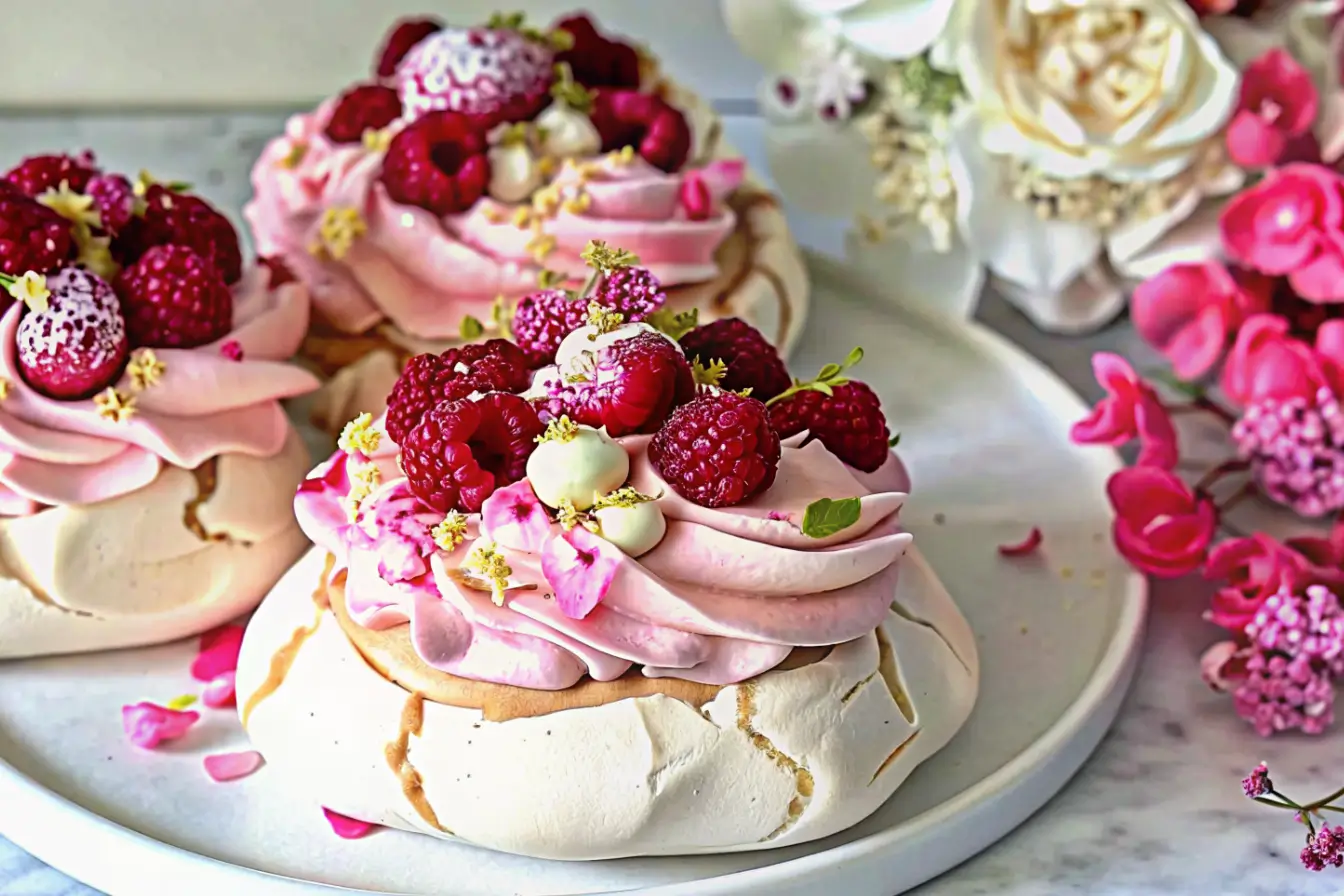
1 thought on “Rose Pavlova Cakes”